 |
 |
 |
| |
An assessment of HIV-HCV co-infection management in Spain:
The ABHACO survey; 61-69% OF HIV infected patients are co-infected with the HCV too
|
| |
| |
Reported by Jules Levin
11th European AIDS Conference/EACS, Madrid, Spain, 24-27th October 2007
J. Gonzalez1, E. Ortega2, J.A. Pineda3, C. Tural, M.J. Perez5, J. Martin5 and E Cabrero5 on behalf of the ABHACO Survey group
(1) Hosp. La Paz, Madrid; (2) Hosp. General Valencia, Valencia;(3) Hosp. Ntra Sra de Valme, Sevilla;(4)Hosp. Germans Trias I
Pujol, Badalona;(5) Abbott Laboratories S.A., Madrid, Spain
BACKGROUND
The HCV infection prevalence in the HIV population in Spain varies depending on the geographic areas, directly related with the area distribution of the risk factors related to these infections transmission. Actually HIV-HCV co-infection prevalence is one of the highest in developed countries due to its direct association with IDU risk factor; thus, 61-69% HIV infected patients are co-infected with the HCV too.
AUTHOR CONCLUSIONS
HIV-HCV co-infection is a significant cause of morbidity/mortality in Spain.
HIV/HCV co-infection influences antiviral selection at the time of initiation of HIV therapy but only half of physicians reported HIV/HCV co-infection influencing the timing of when to start treatment.
Despite the fact that anti-HCV treatment is considered the main factor to control liver fibrosis progression, a relatively low percentage of patients start this treatment. This clinical feature is unknown in a significant percentage of patients.
Further programs focussed on co-infection as increase specific training, are considered needed for an appropriate management of this condition, specially in HIV/HCV patients with decompensated cirrhosis.
Objective
ABHACO survey objective was to get information about the physician's management of HIV/HCV co-infection in routine HIV outpatient clinical practice units in Spain where HIV/HCV co-infection is common.
METHODS
Spanish physicians following >100 HIV+ patients participated in the study.
A 32-item questionnaire, regarding HIV and HIV/HCV, was designed by 4 experts in HIV/HCV co-infection.
These items had been distributed in 5 areas:
· HIV population on follow-up and on HIV-ART;
· HCV and/or HCB co-infection on this population;
· assesment criteria to select HIV ART;
· clinical classification and fibrosis grade among HIV/HCV patients
· and specific management of these last patients.
RESULTS
139 physicians, see Acknowledments, participated in the Survey (collected from April to May 2006) wildely distributed in almost all Authonomous Regions in Spain.
A total of 33,808 HIV patients are on follow-up in these sites (Tab.1) and a 60.4% (mean) are co-infected with HCV (Tab.2)
Table 1. Number of HIV patients on follow-up
An average of 710 HIV+ patients were at each site ranging from a minimum of 90 to a maximum of 2,800. There was an average of 240 HIV+ patients per physician ranging from a minimum of 50 for one physician and a maximum of 900. The average number of patients on ART was 210 (is that per site or per physician) with a minimum of 10 and a maximum of 750.
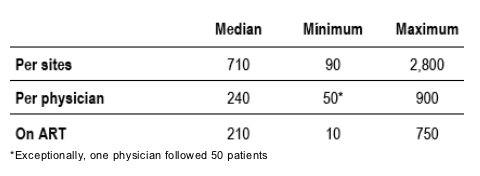
Table 2. HBV and/or HCV co-infection
The median percent of patients with HBsAg is 5% and the median percent of patients anti-HCV is 60%. Of these 80% are PCR-HCV+ and 17.5% have persistently normal ALTs.

Table 3. Rate/causes of death in HIV population during the previous year
The mean rate of death in the past year is 2.9% with 39% dying due to liver disease, 29% due to AIDS, and 21% for other reasons.
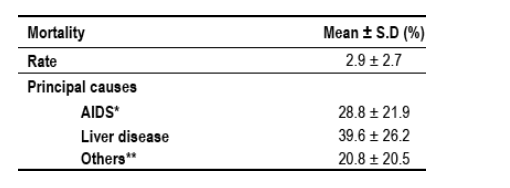
* Significant relationship was found between the ratio "%Liver related deaths/%AIDS related deaths"and the number of co-infected patients followed by the physician (_2: 9.810; g.l. 1; P= 0.044). It was<1 for those physicians following < 100 co-infected pats. while it was >1 for those with > 200 co-infected patients on followup.
** Conversely, no significant association was found between ratio "%Liver related deaths/% other causes related deaths" and the number of co-infected patients followed by the physician (_2: 7.879; g.l. 1; p = 0.096).
A mean of 78.0% (±14.8%) of HIV and 73.1% (±33.6%) of HIV/HCV patients received HIV-1 antiretroviral treatment (ART). The physicians reported as the
most important for patients naive to therapy: efficacy, co-morbidities, and
convenience; and for ART experienced patients: efficacy, resistance, and comorbidities. (Fig.2)
Figure 1. HIV-ART in the co-infected patient
In response to question Does co-infection condition influence on when starting ART? 46% said yes, about 50% said no. In response to question does co-infection condition influence on which ARV drugs are chosen? About 80% said yes, about 20% said no.
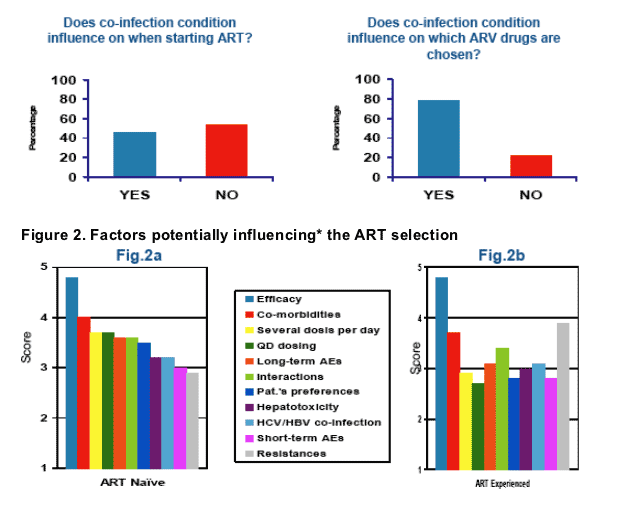
*Score: 1(minimum influence) to 5 (maximum influence); the shown data have been balanced considering the no of coinfected patients on follow-up per physician.
Having HIV/HCV co-infection was a factor that influenced which antivirals were selected by physicians (78%).
However, HIV/HCV co-infection was less of a factor influencing when to begin ART (46%).
Table 4. Hepatic profile for ART as peceived by the physicians
Physician's perception of preferred drugs -those with more or less favorable hepatic profile-in order with most preferable first: FTC, 3TC, TDF, LPV/r, ABC, NFV, AZT, SQV/r, ATV/r, FPV/r, EFV, IDV, DDI, D4T, TPV/r, NVP.
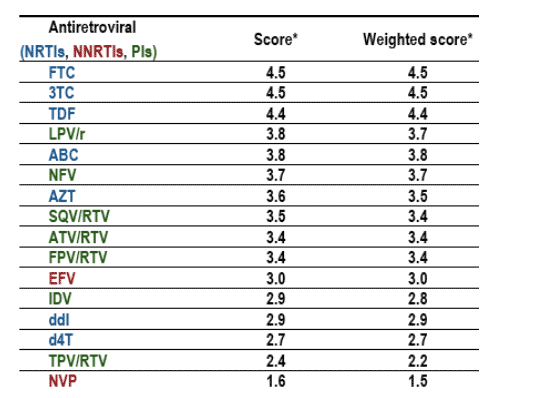
*Score: 1(less favourable hepatic profile) to 5 (most favourable hepatic profile).
The number of HCV/HIV patients (mean ± S.D.) with decompensated cirrosis
per physician during the previous year is 14 ± 18 (mean: 8 patients).
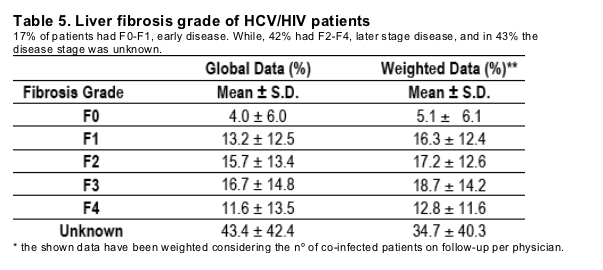
Percutaneous biopsy of the liver was the main diagnostic method employed to determine fibrosis grade (Fig.4). 92.8% of physicians consider useful to know the liver fibrosis grade in HCV/HIV co-infected patients. Despite this, liver biopsy is only available in (mean ± S.D.) 32.5% ± 27.2%; Median: 25.0%
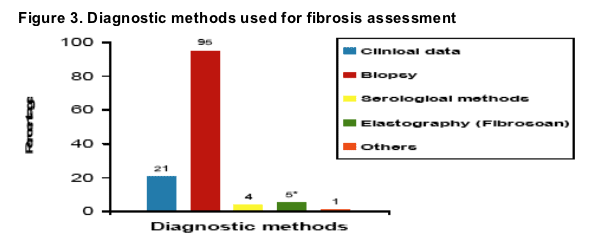
*The methods are not depending on the no of co-infected patients on follow-up (<100, 100-200 or >200) except for elastography which is the 2nd method most used when >200 HIV/HCV patients are on follow-up
Figure 4. Provided reasons to explain the high level of HIV/HCV
patients with unavailable liver biopsy data
of note the most often reason for no liver biopsy data is "Patient does not provide consent for biopsy" 65%. But 59% of physicians say "Biopsy is not considered appropriate", 41% of physicians say "Initiation of HCV therapy is not conditioned to biopsy data", 34% say "Biopsy is contraindicated", 28% say "Initiation of HIV ART is not conditioned to biopsy data", 18% say "Availability problems to perform biopsy", and 21% say "other".
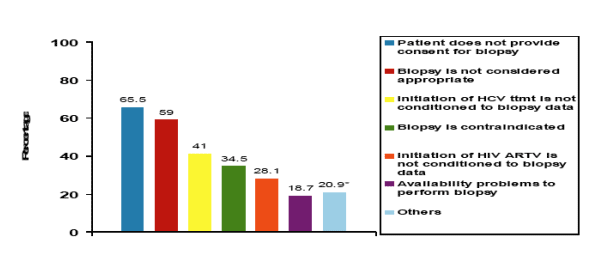
* Others: The hospital has not got biopsy facilities (this has to be done in another site); only those patients to start HCV ttmt. are propossed for biopsy; patients with serious psychiatric pathology; the HIV unit does not manage HCV
infection, it is done in another site Unit
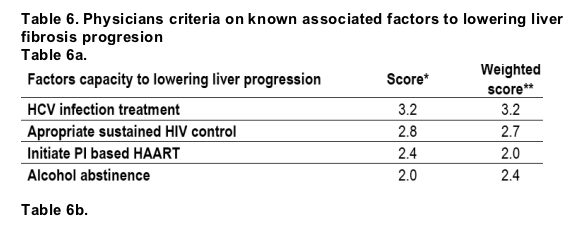
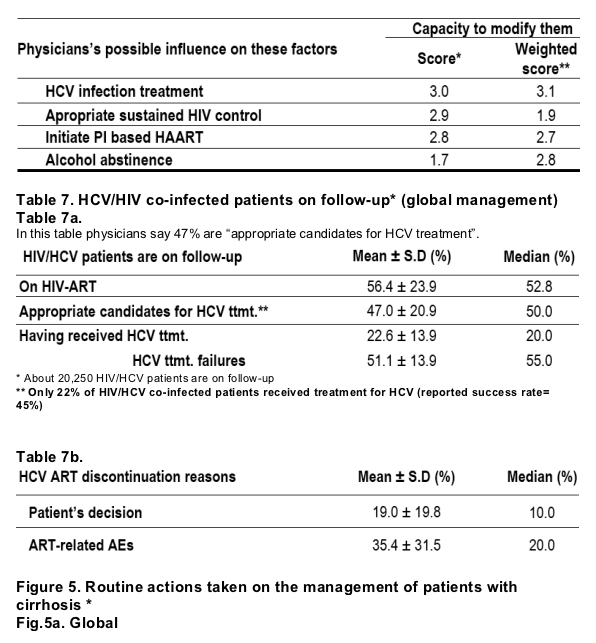
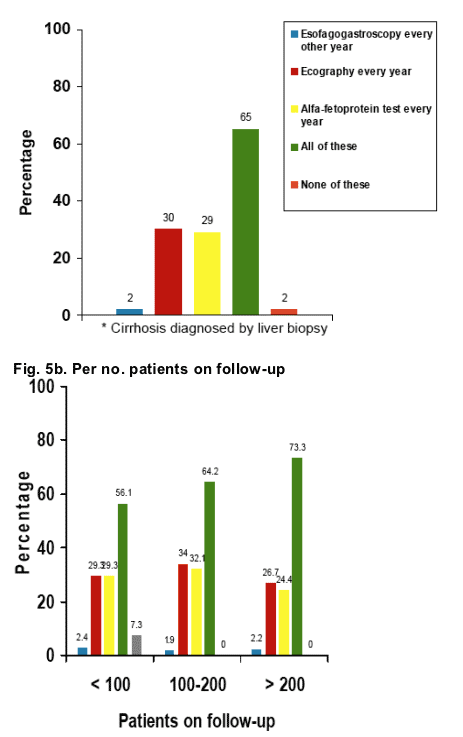
Figure 6. Identified needs to improve the management of the HIV/HCV coinfected patient
Fig. 6a. Global needs
71% of physicians site "Training" and 67% cite "Access to diagnostic tools" as identified needs to improve management of coinfected patients; 31% cite "Cooperation between departments".
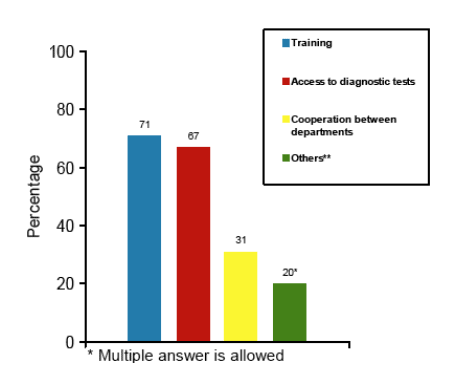
** Others: availability to determine ART levels; disponibility of new agents/drugs for HCV ttmt; more time to dedicate to.
Fig. 6b. Training needs*
Cirrhosis management is the highest rated trainiing need, cited by 46% of physicians, 28% cite "ARVs use", 27% "treatment of HCV infection".
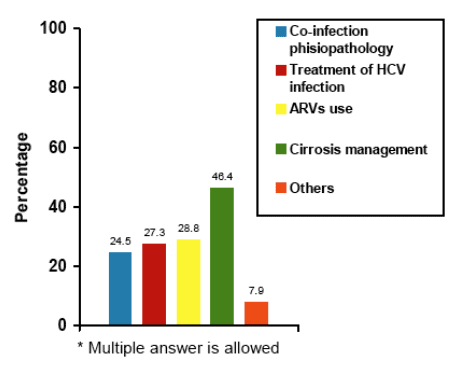
|
| |
|
 |
 |
|
|